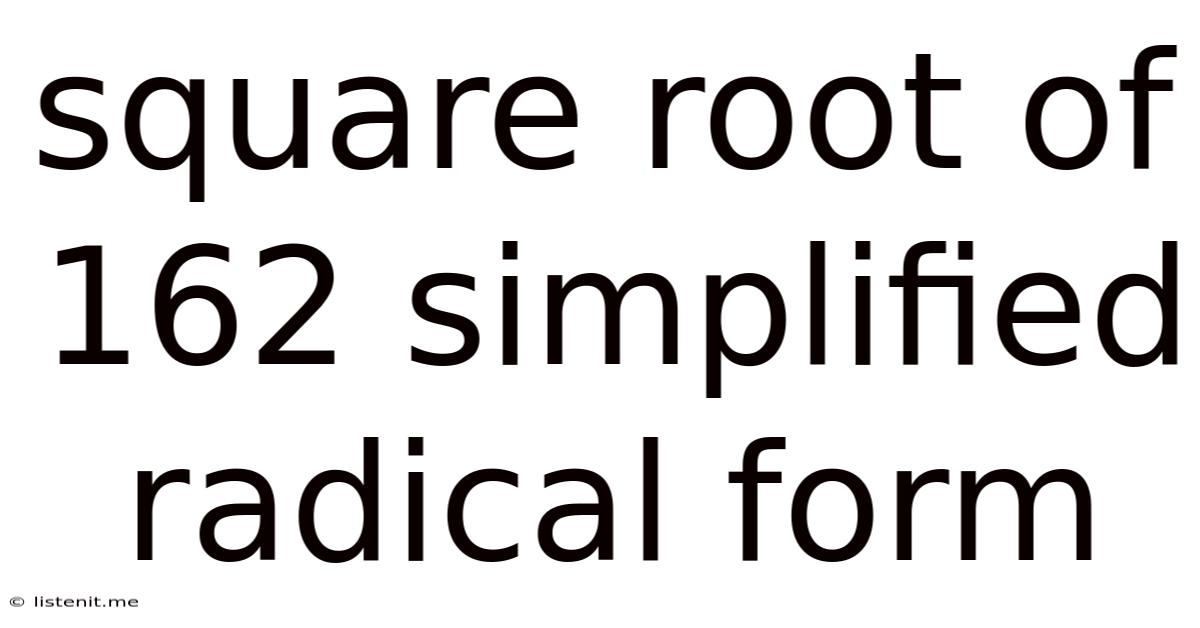Square Root Of 162 Simplified Radical Form
listenit
May 09, 2025 · 4 min read

Table of Contents
Simplifying the Square Root of 162: A Comprehensive Guide
The square root of 162, denoted as √162, might seem daunting at first glance. However, simplifying this radical expression is a fundamental skill in algebra and mathematics. This comprehensive guide will walk you through the process step-by-step, exploring various methods and providing a deep understanding of the underlying concepts. We'll also delve into the broader context of simplifying radicals, offering practical applications and addressing common misconceptions.
Understanding Square Roots and Radicals
Before tackling √162, let's solidify our understanding of square roots and radicals. A square root of a number is a value that, when multiplied by itself, equals the original number. For example, the square root of 9 is 3 because 3 * 3 = 9. The symbol '√' is called a radical symbol, and the number inside the radical symbol is called the radicand.
Radicals are expressions containing a radical symbol. They can be simplified to their most basic form, which often involves finding the perfect square factors within the radicand. A perfect square is a number that results from squaring an integer (e.g., 4, 9, 16, 25, etc.).
Method 1: Prime Factorization
This method is a cornerstone of simplifying radicals. It involves breaking down the radicand into its prime factors. A prime number is a whole number greater than 1 that has only two divisors: 1 and itself (e.g., 2, 3, 5, 7, 11, etc.).
Let's apply this to √162:
-
Find the prime factorization of 162:
162 = 2 × 81 = 2 × 9 × 9 = 2 × 3 × 3 × 3 × 3 = 2 × 3⁴
-
Identify perfect square factors:
We have 3⁴, which is (3²)² = 9².
-
Rewrite the radical expression:
√162 = √(2 × 3⁴) = √(2 × (3²)²)
-
Simplify:
√(2 × (3²)²) = √(2) × √(3²)² = √2 × 3² = 9√2
Therefore, the simplified radical form of √162 is 9√2.
Method 2: Identifying Perfect Square Factors Directly
This method is faster if you can quickly recognize perfect square factors. Instead of fully prime factorizing, you look for the largest perfect square that divides the radicand.
-
Find a perfect square factor of 162:
We can see that 81 is a perfect square (9²) and a factor of 162 (162 = 81 × 2).
-
Rewrite the radical expression:
√162 = √(81 × 2)
-
Simplify:
√(81 × 2) = √81 × √2 = 9√2
Again, the simplified radical form is 9√2. This method demonstrates that identifying perfect square factors directly can streamline the process.
Common Mistakes to Avoid
Several common pitfalls can hinder the accurate simplification of radicals. Let's address them:
- Incorrect prime factorization: Ensuring complete and accurate prime factorization is critical. Missing a factor will lead to an incorrect simplified form.
- Not extracting all perfect squares: Make sure to extract all perfect square factors from the radicand. Leaving a perfect square inside the radical implies incomplete simplification.
- Incorrect application of radical rules: Remember that √(a × b) = √a × √b, but √(a + b) ≠ √a + √b. These rules apply only to multiplication and division, not addition or subtraction within the radicand.
- Forgetting to simplify the coefficient: After extracting the perfect square, remember to simplify any coefficients. For example, if you end up with 6√4, you need to simplify further to 12, not leave it as 6√4.
Practical Applications and Further Exploration
Simplifying radicals is not merely an abstract mathematical exercise. It has practical applications in various fields:
- Geometry: Calculating areas, volumes, and lengths often involves simplifying radicals. For example, finding the diagonal of a square with sides of length 'x' involves the expression √(2x²).
- Physics: Many physics formulas contain radicals, requiring simplification for accurate calculations.
- Engineering: Radicals are essential in structural calculations and design.
- Computer Graphics: Radicals are commonly used in algorithms involving coordinate systems and transformations.
Beyond simplifying √162, the principles discussed here apply to simplifying any radical expression. Try practicing with various numbers, like √72, √288, or √48. Challenge yourself with more complex expressions involving variables and coefficients.
Advanced Concepts: Rationalizing the Denominator
While not directly related to simplifying √162 itself, rationalizing the denominator is a closely related skill often used after simplification. It involves removing radicals from the denominator of a fraction. For instance, if you had an expression like 1/√2, you would rationalize it by multiplying both the numerator and the denominator by √2 to obtain √2/2. This is crucial for simplifying expressions and facilitating calculations.
Conclusion: Mastering Radical Simplification
Mastering the simplification of radical expressions like √162 is a crucial step in developing a strong foundation in algebra and mathematics. By understanding prime factorization, identifying perfect square factors, and avoiding common mistakes, you can confidently simplify radicals and apply this knowledge to various mathematical and real-world problems. Remember, consistent practice and a solid understanding of the underlying principles are key to achieving proficiency in this fundamental skill. Continue practicing and exploring more advanced concepts like rationalizing the denominator to enhance your mathematical abilities.
Latest Posts
Latest Posts
-
Which Of These Groups Is The Smallest Level Of Classification
May 11, 2025
-
Rutherfords Gold Foil Experiment Determined That
May 11, 2025
-
Common Multiples Of 7 And 4
May 11, 2025
-
Sum Of The First 10 Positive Integers
May 11, 2025
-
What Food Is Nucleic Acids Found In
May 11, 2025
Related Post
Thank you for visiting our website which covers about Square Root Of 162 Simplified Radical Form . We hope the information provided has been useful to you. Feel free to contact us if you have any questions or need further assistance. See you next time and don't miss to bookmark.